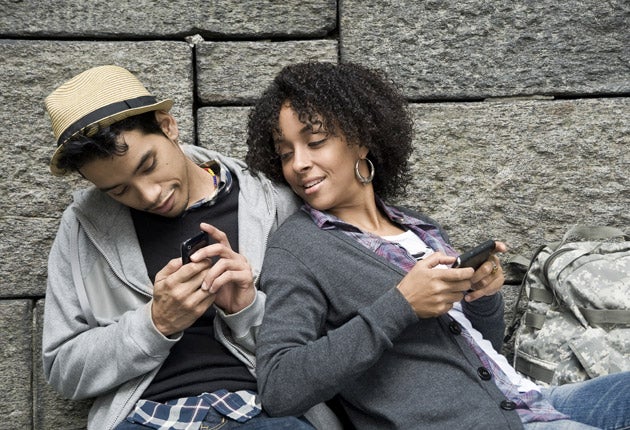My Virtual Valentine
Handwritten letters are the exception rather than the rule for modern romantics. But can an e-card or text satisfy your tweet-heart? Alice-Azania Jarvis on how to say 'i luv u'

So how was this morning for you? Did you rush downstairs and find the hallway overflowing with flowers?
The doormat scattered with love letters? Can you expect a delivery of chocolates and champagne at the office, perhaps accompanied by handwritten verse declaring the author's undying devotion?
Presumably, for some, the answer is yes. Valentines is big business in the UK. Today, an estimated £42.3m worth of greetings cards will exchange hands. Indeed, the combined value of the various bouquets, trinkets and foodstuffs sold in the run-up to the 14th is thought to be more that £1.3bn. And yet, things are a-changing. These days, say the experts, we're just as likely to express our affections through the medium of text message as we are to pop a note in the post. In fact, more so.
In 2009, the National Trust pronounced the death of the love letter when its survey of 2,558 people found that almost two-thirds had never put pen to paper to convey their love. Since then, the billet-doux has shown no sign of rallying. Only 9 per cent of those questioned this year had ever sent a love letter – and most of those were over the age of 50. Instead, text messages and emails have become the order of the day.
"The explosion of technology had totally changed the way we go about courtship," explains relationship psychologist Jo Hemmings. "There is a whole new range of options available that were inconceivable before." Services abound offering amorous couples the chance to demonstrate their affections digitally. At E-cards.co.uk, you can attach a photo of your head to a tumbling body and send your beau a film of your "falling for them". Using your iPhone, you can put your love into words, thanks to the handy Love Poem Generator. And for those planning to pop the question today, there's always the iPropose app to give you a hand.
It's tempting, of course, to brand technology the ruination of romance. You don't have to be John Keats to see that texting "I luv u" doesn't hold quite the same seductive quality as crafting a handwritten note. What, after all, is a smartphone-generated poem in comparison with the heart-stricken outpourings of prior generations? And when you're explaining to your grandchildren the story of your courtship, do you really want a mass-produced gizmo to hold a starring role? As Hemmings notes: "It's impersonal – there's not the sentimental value that you might have otherwise."
But hold on a sec. Before we get too caught up in a squall of nostalgia, let's examine a few facts. John Donne may have penned a rather fetching Valentine verse in 1613, but since then what have we had? Centuries of dross. Decades of roses-are-red-violets-are-blue. As anyone who has ever been on the receiving end of a self-composed bit of poetry can confirm, it isn't a skill that comes easily to many. Perhaps, rather than shunning the Love Poem Generator, we should be cheering its role in offering a lowest common denominator. Likewise those other Love 2.0 innovations: the iPickupLines and iFlirt apps. Anything – computer generated or otherwise – that encourages potential suitors to stray from the standard routine of come-here-often? / don't-I-know-you / hey-sexy can't really be a bad thing. Can it?
And that's before we even question how sacred an occasion Valentine's was anyway. Long before email, iPhones and online dating barged on to the scene, the 14th was being robbed of any romance by other forces. Even as the day's customs were evolving, in post-industrial Britain, the occasion was assuming all the trappings of a corporate profit fest. Our habit of sending anonymous cards is largely a function of the volume of so-called "mechanical valentines" being produced by Victorian printers. By the early 19th century "fancy valentines" – once a home-made symbol of affection – were being manufactured en masse. And as early as 1797, a publisher had issued The Young Man's Valentine Writer, complete with dozens of suggested verses to aid the tongue-tied lover. It was, in essence, the Love Poem Generator of its day.
Since then, Valentine's Day has only become less and less of an occasion. When everyone from Tesco to your local trattoria is trying to make a quick buck from your love life, celebrating that special someone can feel rather less, well, special. Adverts for the various Valentine products available – beauty products, mini-breaks, wine cases, even electricals and homewares – began popping up months ago. Was there ever a romantic occasion so lacking in spontaneity, so thoroughly unromantic in every way?
So this year, perhaps the most romantic thing you could do would be to refrain from tradition and embrace something new. Tired of greeting-card clichés and petrol-station bouquets, it may be time to start a new tradition. Send a text. Send an email. Hey, at least it's home-made.
Join our commenting forum
Join thought-provoking conversations, follow other Independent readers and see their replies
Comments
Bookmark popover
Removed from bookmarks